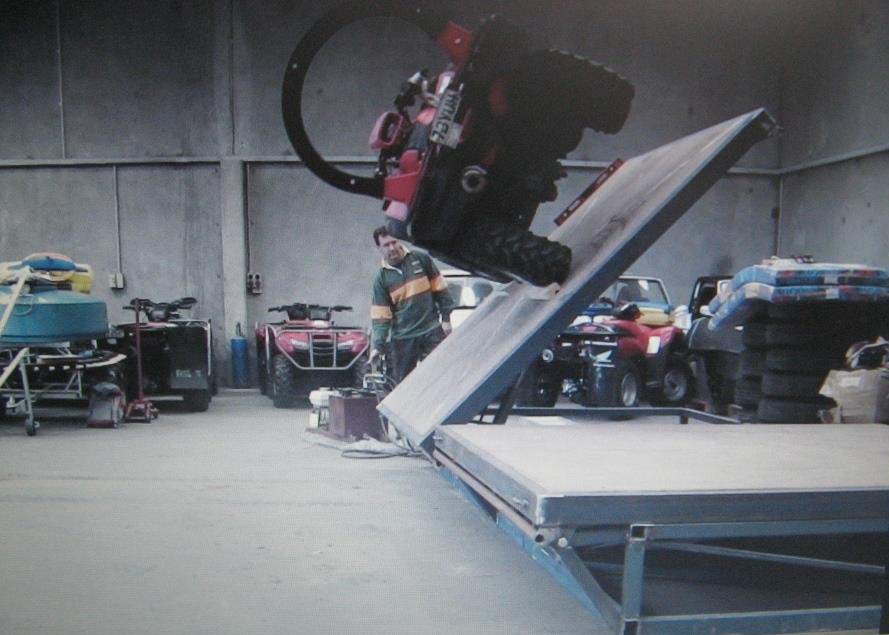LifeGuard Research
LIFEGUARD CONCEPT DEVELOPMENT
Having been involved with ATVs for many years, firstly the trikes, then with the introduction of quads we are well aware of the whole history of this market, and the research and development involved, including the roll bar saga.
When Honda became involved, we were invited to Wellington to a meeting and were shown the videos etc and heard the whole nine-yards of their campaign. We were effectively stopped from making our bars along with all the other manufacturers, or maybe more correctly, people and motorcycle dealers were stopped from buying and fitting them. We know the main reason behind this campaign was not the safety issue, but the litigation in the USA regarding quad bike injury or death.
An interesting point is, that according to research by the Department of Labour for statistics on quad bike accidents in New Zealand, the most common accident causing serious injury or death was a slow speed sideways roll on the side of a hill. This is 75-80% of call out accidents and if you go back and look at Honda’s video this particular accident showed the rider was better off with a roll bar. However, they based their findings on the average results of the combination of 60 plus different accidents, most of which were hypothetical and would very seldom or possibly never happen in reality. This shows the findings were flawed and not accurate.
In saying this we do see the potential risk and danger of a rider being struck by the roll bar if thrown off, and no doubt this has happened and is still likely to happen. We know the Health & Safety Personnel and the Department of Labour are looking for answers and some way to reduce fatalities in this serious issue. We also know that since roll bars have been removed there have been more serious injuries and deaths than when they were in use. The highest cause of serious injury and deaths on New Zealand Farms is attributed to ATV (quad) accidents.
FOUR MAIN SAFETY MESSAGES FOR QUAD’S
These safety messages have been sourced from the Ministry of Business, Innovation and Employment (MBIE). To view their newsletter on Quad Safety.
- Riders must be trained/experienced enough to do the job.
- Choose the right vehicle for the job.
- Always wear a helmet.
- Don’t let kids ride adult quad bikes.
As it is not feasible to fit a seat belt to a quad because of its rider’s active nature, there is therefore the strong possibility in the event of an accident of the rider being thrown off and crushed or injured by the quad or the roll bar. We see an urgent need for some way to limit this, something that can hold a quad up off the ground to provide crush protection but also more importantly something that is less likely to cause injury or death if it comes in contact, strikes or lands on the rider. The only bars that are available to our knowledge are rigid, hard steel bars of various types but have very little, if any, flexibility and although they give crush protection, not all can bear the full weight of up to 350kg off the rider.
There must be a better way. This is where the LifeGuard concept started.

BEGINNING OF THE LIFEGUARD
I heard of the Roman Arc principle which consists of individual segments fitting together to form an Arc and held together by internal tensioned cables.
The interesting thing about this concept is if you slacken the tension a little on the cables, the arc can flex or move or alter in shape, but as long as the ends are fixed, it is unable to collapse. This was the starting point of this innovation. Why not apply this to a roll bar – very strong, but flexible...
The first prototype was a very crude miniature model built with a wood base and wooden segments. This proved to us that the concept would in fact actually work. We then made a full-size prototype with steel base and experimented with different shaped segments and different strength springs. The next step was fitting one to a quad and rolling it down a bank, then placing over a person on the ground. We could then see the potential in this product.
A lot of on-going development has followed with the help of Industrial Research Ltd – Technology Engineers, to finally come up with the present LifeGuard which has nylon segments, alloy base, built-in winch, spring loaded mechanism, and neoprene cover.
The final step has been a rigorous testing program which is now completed, and we feel that this product is now ready for production.
Vernon T. Suckling



